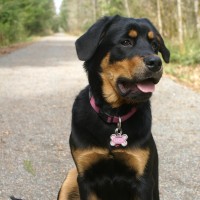Appearance of the Bernese Rottie
|
| The Bernese Rottie is a modern and largely unknown breed. It's difficult to determine exactly what these dogs will look like, as they can take on the characteristics of both parents. Bernese Mountain Dogs are compact, with deep, broad chests and a furrow running down the middle of their broad heads. Their ears are triangular and pendulous, and their eyes are dark. These dogs keep their long, bushy tails low, unless they're excited. Rottweilers are athletic dogs with muscular bodies and very large, broad heads. They are not as tall as they are long and have level toplines. They also have hanging, triangular ears, with a broad nose that is black, like their lips and the inside of their mouth. The almond-shaped eyes will be dark brown and deep, and the Rottweiler's teeth will meet in a scissor bite. |
Temperament of the Bernese Rottie
|
| The Bernese Rottie is an intelligent, talented dog that will excel at a variety of jobs, such as police work, carting, guarding, weight pulling and breeding. They protect their families and will alert and attack all intruders. Apart from these characteristics, you can expect this hybrid breed to adopt certain personality traits from its parents. Bernese Mountain Dogs are true pets, and they love nothing more than spending time with their families. Gentle, affectionate dogs, they will be calm and patient around children. These dogs also get along with other pets and are polite with new people, but can sometimes be shy, so it's important to socialize them well. They can spend all day playing, but will also enjoy relaxing. They are docile but can be slow to train. Be sure to be patient and give plenty of positive encouragement. Unfortunately, Rottweilers have developed a reputation for being vicious. However, this is not their natural behavior, and they will only be aggressive if they have been trained in this way. They are very loyal and protective of their families, which makes them good watchdogs. They will be playful and affectionate as long as they are well socialized. With strangers, these dogs will be reserved until they decide that the person is worthy of their time and affection. They need experienced owners, as they can be difficult to train. You need to be gentle but tough and confident with this breed. |
Needs and activities of the Bernese Rottie
|
| The Bernese Rottie has lots of energy and will need regular exercise, but will also love to relax and take naps. With their long, thick coats, this breed is best suited to winter temperatures and should not be over-exercised in hot weather. Rottweilers can be bored and destructive if not sufficiently exercised. The Bernese Rottie can do the same. |
Maintenance of the Bernese Rottie
|
| The Bernese Rottie will have different levels of maintenance depending on the parent it most resembles. Bernese Rotties shed all year round, but more heavily during the changing seasons. Therefore, you should brush them weekly, and more often in autumn and spring. They only need baths every few months, unless they like to play in the dirt. Rottweilers will also need weekly brushing, more often twice a year as their shedding increases. Only bathe them when necessary. In addition to grooming, all dogs, including the Bernese Rottie, should have their ears cleaned and checked at least once a month to prevent the development of infections. Teeth brushing is also a must, and should be carried out daily if possible. Two or three times a week should be the minimum. Trim your dog's nails as needed, which will be once or twice a month, unless they wear down on their own, in which case this can be done less often. |









 English (United Kingdom)
English (United Kingdom)